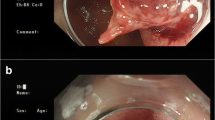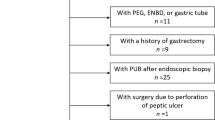Abstract
A total of 902 surgical patients with peptic ulcer disease were evaluated to clarify the effects of H2-receptor antagonists and endoscopic hemostasis on surgical treatment. Following the introduction of these treatments to our institute in 1982, the number of operations performed annually decreased by 40%, or 36 cases per year. However, a remarkable increase in the frequency of surgical emergency intervention since 1982 was concurrently observed, with the ratio of emergency procedures to the total number of operated cases increasing to 72.5% in the last 5 years of the study. Moreover, intractability as an indication for surgery decreased to 34.1%, compared with an increase in the number of patients with bleeding and perforated ulcers requiring operation. There were 13 postoperative deaths recorded (1.4%). All of the deaths were in patients who had undergone emergency surgery in poor health. Of these 13 patients, 10 had bleeding ulcers. A study of bleeding ulcers for which endoscopic hemostasis had been unsuccessful revealed that shock on admission and a concomitant medical condition had been evident in all the patients who died, and in 52.2% and 30.4% of the survivors, respectively. The current study suggests that the frequency of high-risk patients requiring surgery is increasing since the introduction of H2-receptor antagonists and endoscopic hemostasis, and thus, prompt surgical treatment and intensive management for such patients is essential.
Similar content being viewed by others
References
Sachdeva AK, Zaren HA, Sigel B (1991) Surgical treatment of peptic ulcer disease. Med Clin North Am 75:999–1012
Fineberg HV, Pearlman LA (1981) Surgical treatment of ulcer in the United States. Trends before and after the introduction of cimetidine. Lancet 1:1305–1307
Bublick MP (1984) Control of acute gastrointestinal hemorrhage with cimetidine. Surgery 84:510–515
Donahue PE, Mobarhan S, Layden TJ, Nyhus LM (1984) Endoscopic control of upper gastrointestinal hemorrhage with a bipolar coagulation device. Surg Gynecol Obstet 159:113–118
Christensen A, Bousfield R, Christiansen J (1988) Incidence of perforated and bleeding peptic ulcers before and after the introduction of H2-receptor antagonists. Ann Surg 207:4–6
Moritomo H, Nagahata Y, Urakawa T, Takeda K, Hashimoto Y, Ichihara T, Saitoh Y (1990) A study of bleeding peptic ulcer in the elderly in the view of risk factors (in Japanese with English abstract) Nippon Geka Gakkai Zasshi (J Jpn Surg Soc) 91:206–213
Earnest DL (1991) Maintenance therapy in peptic ulcer disease. Med Clin North Am 75:1013–1038
Sontag S (1988) Current status of maintenance therapy in peptic ulcer disease. Am J Gastroenterol 83:607–617
Wyllie JH, Clark CG, Williams JA (1981) Effect of cimetidine on surgery for duodenal ulcer. Lancet 1:1307–1308
McEntee G, Ryan W, Peel ALG, Rosenberg IL, Devlin HB, (1988) A district general hospital experience of surgical treatment of gastric and duodenal ulcer from 1970 to 1982. Surg Gynecol Obstet 167:53–60
Jensen MO, Bubrick MP, Onstad GR, Hitchcock CR (1985) Changes in the surgical treatment of acid peptic disease. Am Surg 51:556–558
Johnston D (1975) Operative mortality and postoperative morbidity of high selective vagotomy. Br Med J 4:545–547
Bloom BS, Fendrick AM, Ramsey SD (1990) Changes in peptic ulcer and gastritis/duodenitis in Great Britain, 1970–1985. J Clin Gastroenterol 12:100–108
Christiansen P, Jensen HE, Amdrup E, Fender C, Lindskov J, Nielsen J, Nielsen SAD (1978) Gastric ulcer in old age. Acta Chir Scand 144:491–494
Bekada H, Charikhi M, Haicheur R, Yanes Y, Mentouri B (1984) Bleeding peptic ulcer 10 years' experience. Am J Surg 147:375–377
Kulber DA, Hartunian S, Schiller D, Morgenstern L (1990) The current spectrum of peptic ulcer disease in the older age groups. Am Surg 56:737–741
Hunt PS (1986) Bleeding ulcer: Timing and technique in surgical management. Aust N Z J Surg 56:25–30
Asaki S, Nishimura T, Sato A, Yamagata R, Okubo S, Toyohara T, Saito Y, Ito S, Miyazaki S (1988) Efficacy of absolute ethanol injection for upper gastrointestinal massive bleedings with hemorrhagic shock. Tohoku J Exp Med 156:7–11
Branicki FJ, Boey J, Fok PJ, Pritchett CJ, Fan ST, Lai ECS, Mok FPT, Wong SK, Hui WM, Ng MNT, Lok ASF, Lam DKH, Tang APK, Coleman SY, Wong J (1989) Bleeding gastric ulcer: a prospective evaluation of rebleeding and mortality. Aust N Z J Surg 59:551–562
Turner B, Jones M, Piper DW (1991) Factors influencing mortality from bleeding peptic ulcers. Scand J Gastroenterol 26:661–666
Bondner B, Harrington ME, Unsup K (1990) A multifactorial analysis of mortality and morbidity in perforated peptic ulcer disease. Surg Gynecol Obstet 171:315–320
Taylor H (1957) Guest lecture: The non-surgical treatment of perforated duodenal ulcer. Gastroenterol 33:353–368
Katkhouda IV, Mouiel J (1991) A new surgical technique of treatment of chronic duodenal ulcer without laparotomy by videocelioscopy. Am J Surg 161:361–364
Mouret P, Francois Y, Vignal J, Barth X, Lombard-Platet R (1990) Laparoscopic treatment of perforated ulcer (short note). Br J Surg 77:1006
Choi S, Boey J, Alagaratnam TT, Poon A, Wong J (1986) Proximal gastric vagotomy in emergency peptic ulcer perforation. Surg Gynecol Obstet 163:531–535
Simpson CJ, Lamont G, Macdonald, Smith IS (1987) Effect of cimetidine on prognosis after simple closure of perforated duodenal ulcer. Br J Surg 74:104–105
Masberger JA (1987) Endoscopic follow up of the perforated duodenal ulcer. Am J Surg 53:46–49
Ravinovia R, Manny J (1991) Perforated duodenal ulcer in the elderly. Eur J Surg 157:121–125
Author information
Authors and Affiliations
Rights and permissions
About this article
Cite this article
Ishikawa, M., Ogata, S., Harada, M. et al. Changes in surgical strategies for peptic ulcers before and after the introduction of H2-receptor antagonists and endoscopic hemostasis. Surg Today 25, 318–323 (1995). https://doi.org/10.1007/BF00311253
Received:
Accepted:
Issue Date:
DOI: https://doi.org/10.1007/BF00311253




